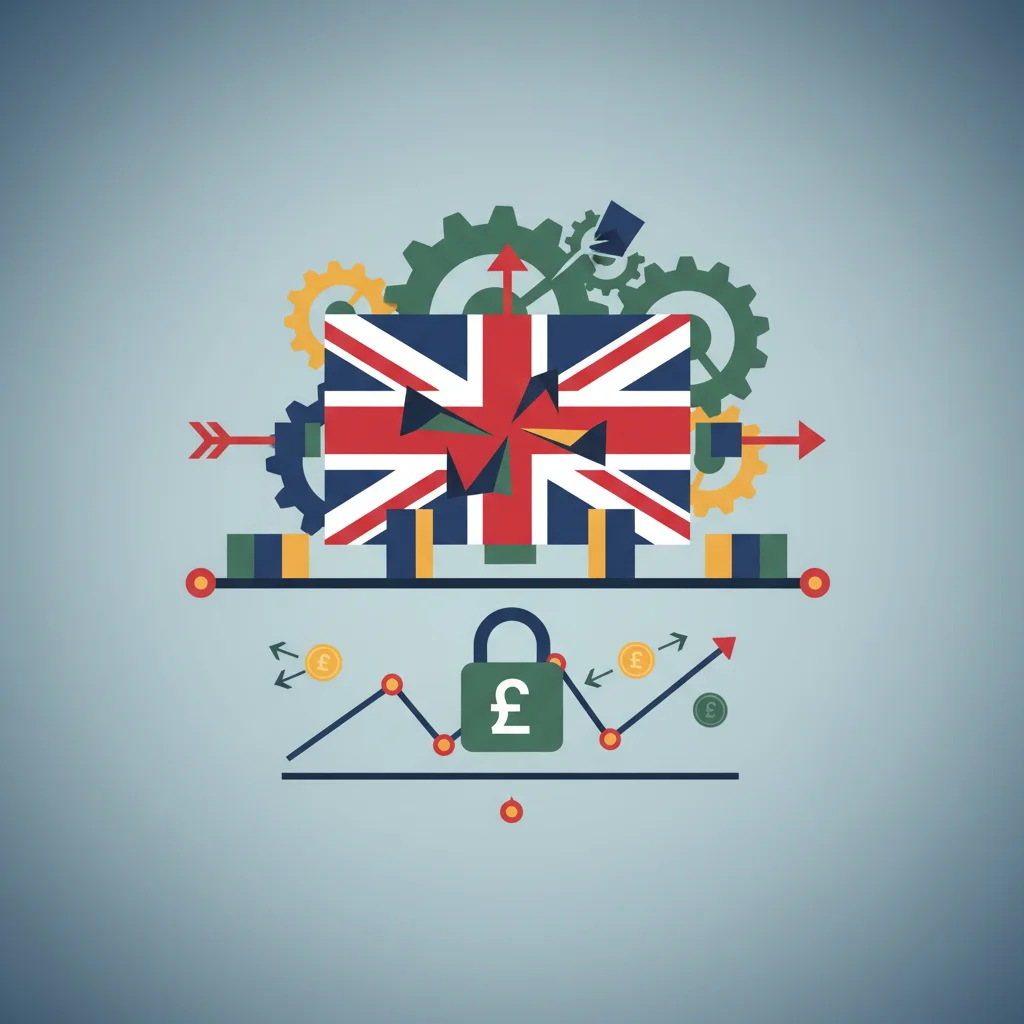
The Great British Standstill: Decoding the UK’s Economic Flatline and What It Means for Your Portfolio
An Economy on Pause: Understanding the UK’s Current Economic Stalemate
In the grand narrative of national economies, momentum is everything. Growth signals prosperity, opportunity, and forward motion. Contraction, or recession, signals alarm. But what happens when the story simply… stops? The latest economic data reveals a UK economy caught in a state of suspended animation, neither growing nor shrinking but locked in a precarious standstill. According to the most recent figures from the Office for National Statistics, the UK’s Gross Domestic Product (GDP) showed 0.0% growth in the last quarter, a figure that speaks volumes through its silence. This flatline performance isn’t just a statistic; it’s a reflection of a complex interplay of high interest rates, persistent inflation, and global uncertainty that is impacting everything from household budgets to corporate investment strategies.
For investors, business leaders, and anyone with a stake in the UK’s financial future, this period of stagnation raises critical questions. Is this a temporary lull before a recovery, or the beginning of a prolonged era of low growth? What does this mean for the stock market, for innovation in fintech, and for the broader landscape of investing? In this deep dive, we will dissect the numbers, explore the underlying causes of this economic inertia, and provide an expert perspective on how to navigate the challenges and opportunities that lie ahead.
A Deeper Look at the Data: Which Sectors are Stalling?
To truly grasp the situation, we must look beyond the headline GDP figure. A 0.0% growth rate masks a turbulent reality beneath the surface, with different sectors of the economy pulling in opposite directions. The services sector, which is the dominant force in the UK economy, showed marginal growth, but this was entirely offset by contractions in manufacturing and construction, painting a picture of a deeply fragmented economic landscape.
Here is a simplified breakdown of the sectoral performance in the last quarter, which illustrates this divergence:
| Economic Sector | Quarterly Growth Rate | Key Contributing Factors |
|---|---|---|
| Services | +0.2% | Resilience in professional services and information technology, partially offsetting weakness in consumer-facing areas. |
| Manufacturing & Production | -0.3% | Weak global demand, high energy costs, and supply chain frictions continue to hinder output. |
| Construction | -0.5% | High interest rates have significantly dampened new housing projects and commercial developments (source). |
This data highlights a critical vulnerability: the UK’s heavy reliance on the services sector to keep its head above water. The poor performance in construction and manufacturing is a direct consequence of the current high-interest-rate environment, designed by the Bank of England to curb inflation. This policy, while necessary from a monetary perspective, is clearly acting as a powerful brake on economic activity.
Steel Over Startups: Decoding the UK's High-Stakes Pivot in Industrial Strategy
The Anatomy of Stagnation: Three Forces Holding the UK Economy Back
An economy doesn’t just grind to a halt by accident. The current situation is the result of several powerful, interconnected forces. Understanding these drivers is essential for anyone involved in finance or economics.
1. The Persistent Sting of Inflation
While the headline inflation rate has fallen from its peak, the cumulative effect of price rises over the past two years continues to erode household purchasing power and corporate profitability. Consumers are more cautious with their spending, and businesses are struggling with elevated costs for energy, raw materials, and labour. This squeeze on real incomes means less demand in the economy, making it difficult for businesses to grow.
2. The Bank of England’s Monetary Vise
To combat that inflation, the Bank of England has raised interest rates to their highest level in over 15 years. This monetary tightening is a blunt but effective instrument. It makes borrowing more expensive for both consumers (mortgages, loans) and businesses (investment capital), deliberately slowing the economy down. The stagnation we are now seeing is, in part, the intended outcome of this policy. The key challenge for the central bank is to tame inflation without tipping the economy into a full-blown recession—a notoriously difficult balancing act.
3. Global Economic Headwinds
The UK is not an island, economically speaking. Sluggish growth in key trading partners like the Eurozone and China means weaker demand for British exports. Geopolitical instability and ongoing supply chain realignments add another layer of complexity and cost for UK businesses operating on the global stage. This external pressure further restricts the potential for an export-led recovery.
Navigating the Flatline: Strategic Implications for Investors and Businesses
A stagnant economic environment requires a shift in strategy. The high-growth, low-interest-rate world of the previous decade is gone. Success now depends on resilience, efficiency, and a deep understanding of the new landscape.
For the Modern Investor: A Focus on Quality and Innovation
For those involved in investing or trading, a flat economy doesn’t mean a lack of opportunity, but it does mean that opportunities are harder to find. Broad market gains are less likely, so a more selective approach is crucial.
- Defensive Sectors: Companies in non-cyclical sectors like healthcare, consumer staples, and utilities tend to perform more reliably as their products and services are in demand regardless of the economic climate.
- Strong Balance Sheets: Focus on companies with low debt and strong cash flow. They are better equipped to weather periods of high borrowing costs and weak demand.
- The Innovation Catalyst: Paradoxically, economic pressure can be a powerful catalyst for innovation. This is particularly true in the world of financial technology. Companies that offer solutions to improve efficiency, reduce costs, or provide better financial services will thrive. Keep an eye on the fintech sector, especially firms specializing in automation, AI-driven analytics, and next-generation banking platforms. Even technologies like blockchain, while still maturing, offer long-term potential for revolutionizing supply chains and transaction security, which becomes more appealing when efficiency is paramount.
Grounded Nation: How Airport Chaos Reveals Deep Fissures in the US Economy
For Business Leaders: A Time for Efficiency and Strategic Pivots
For businesses, stagnation means navigating a treacherous environment of weak consumer confidence and high operating costs. The focus must shift from aggressive expansion to building a more resilient and efficient operation.
- Operational Efficiency: Leverage technology to automate processes, optimize supply chains, and reduce overheads. This is where the practical application of fintech and other enterprise technologies can provide a significant competitive edge.
- Customer Retention: In a market where new customers are hard to come by, focusing on retaining and upselling to your existing client base is critical. Superior service and value are key differentiators.
- Strategic Investment: While large-scale capital expenditure might be on hold, targeted investments in technology, training, and R&D that promise a clear and rapid return on investment should be prioritized.
The Path Forward: Can the UK Reignite Its Economic Engine?
The road ahead for the UK economy is uncertain. Escaping this state of stagnation will require a combination of careful policy-making, a resilient private sector, and a degree of luck on the global stage. The Bank of England holds the most immediate key; a future decision to begin lowering interest rates would provide a significant boost to confidence and activity. However, this move is entirely dependent on inflation being brought firmly under control.
On the fiscal side, the government faces a choice between maintaining discipline to reassure markets or deploying stimulus to kick-start growth. Future policies on taxation, infrastructure investment, and skills training will play a crucial role in shaping the UK’s long-term productivity, which is the ultimate driver of economic prosperity. For now, the focus remains on navigating the present.
Wall Street's Warning Bell: Is the US Financial System's Plumbing About to Clog Again?
Conclusion: A Call for Resilience and Strategic Foresight
The UK’s economic flatline is a sobering reminder of the challenges facing developed economies in a post-pandemic, high-inflation world. This is not a moment for panic, but for pragmatic and strategic thinking. For investors, it underscores the timeless virtues of diversification, a focus on quality, and an awareness of the innovative sectors poised to solve today’s problems. For business leaders, it is a call to double down on efficiency and customer value. While the headline figures may be uninspiring, the underlying dynamics of the economy are creating a new set of winners and losers. Understanding this shift is the first, and most important, step in successfully navigating the great British standstill.


